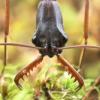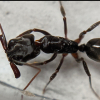Now I have a trachymyrmex queen with a successful fungus garden she started herself. I have several questions about this species:
1. Do they need to mate with as many males as atta or acromyrmex do?
2. Do they have "bad" queens, i.e. alates that took off their wings and act as workers (I've heard this is quite common in acromyrmex)? I found mine not far away from a bunch of workers and she hasn't laid any eggs yet so she might be infertile.
3. Are they as fussy about temperature and humidity as atta and acromyrmex?
I know what plants they harvest and I'm near them so no problem, the fungus is ok, in other words all the usual things you need to worry about when raising fungus growers are under control. What I need to know is if there is a possibility that my queen is not fertile.
If these seem like newbie questions I'm sorry, just want to know if there is a possibility that I might be wasting my time trying to raise this queen.
I've had her for about 2 weeks if that's relevant at all, still no eggs.




















